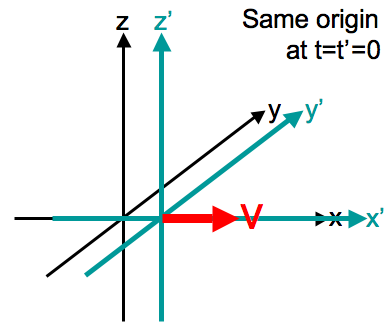
Caption: The standard image of a coordinate system for explaining both the Galilean transformations of classical physics and the Lorentz transformations of special relativity.
Features:
- The primed coordinate system
x-axis slides at
velocity V
along the x-axis of the unprimed
coordinate system with
the other axes being the same for both
coordinate systems.
At time zero, the 2 coordinate systems exactly overlapped.
- The transformation formulae show how
variable in one
coordinate system
are related to those in
the other coordinate system.
For example, the Galilean transformation for a velocity in the x direction from the unprimed to the primed coordinate system is
v_x' = v_x - V and the inverse is v_x = v_x' + V
which is what you would expect. - The most striking fact about the
Lorentz transformations
is that the time coordinate changes between the
coordinate systems.
This does NOT happen with the Galilean transformations---which were the transformations that were thought to be exactly correct (by most people) before the discovery of special relativity in 1905 by Albert Einstein (1879--1955).
Image link: Wikipedia: File:Standard conf.png.
Local file: local link: frame_transformations.html.
File: Relativity file: frame_transformations.html.